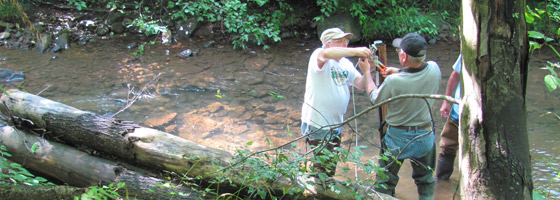Penn. volunteer group monitors water quality in Allegheny River headwaters

With a corps of dedicated volunteers and a fleet of level loggers, a county-based environmental group is keeping an eye on its section of the Allegheny River watershed.
Evergreen Conservancy, an environmental non-profit based in Indiana County, Penn., is monitoring water quality at 23 stream sites in the headwaters of the Allegheny River. They’re using the Solinst Levelogger Junior to measure water level, temperature and conductivity every 15 minutes.
The group hopes to add few more sites for a total of around 30, said Cindy Rogers, president of the conservancy’s board. The first goal is to collect a full year’s worth of data to better understand how each stream functions through high and low water and four seasons.
Having a full year of data as a reference point will make it easier for the group and its partners to detect changes in water quality that aren’t just natural fluctuations or the quirks of a particular stream, she said.
“What we didn’t want to happen was for people to see spikes in the data and panic because they thought something was not right,” she said. “You might see one stream running higher than the other, and it may just be how that runs.”
Though the monitoring project was driven in part by concerns over potential water quality impacts of Marcellus shale natural gas development in Indiana County, Rogers said the group is looking at the effects of all non-point pollution sources in the area’s streams. That makes conductivity a good parameter for them to track.
“It can pick up soil and sedimentation, erosion, it can pick up sewage issues, it can pick up Marcellus shale spills or accidents,” she said. “We got some spikes in our data recently, and it was probably because of winter road treatment.”
The monitoring project is the result of a wide collaboration between other groups focused on water quality and Evergreen’s dedicated volunteers. Grant funding for the project has come from the Colcum Foundation and the Pennsylvania Department of Environmental Protection’s Growing Greener Funds. Local groups like the Central Indiana County Water Authority, the Ken Sink Chapter of Trout Unlimited, and the Western PA Conservancy have contributed funds or equipment. Indiana University of Pennsylvania developed and maintains a database for the project’s measurements, and university geology students are working on stream assessments and data analysis, Rogers said.
Data from the monitoring equipment is downloaded by a group of volunteers, some retired and others working full-time. Some of them are fishermen or members of local watershed groups. Others just love the outdoors, Rogers said.
Evergreen’s volunteers proved particularly important in August 2011, when Hurricane Irene caused major flooding throughout the Eastern U.S. After the floods, a group went out to download the data from a site near Little Mahoning Creek. The level logger had been mounted to a pole that was driven into the stream bed. For extra security, the logger  was cabled to a stream bank stabilization project made up of massive logs held in place with rebar.
was cabled to a stream bank stabilization project made up of massive logs held in place with rebar.
But the storm washed it all away.
“We went back up to download the data, and everything was gone. The data logger was gone. The pole was there, but it was bent in half,” Rogers said. “Water rose probably six feet, and took out the whole stream bank stabilization project.”
Two weeks later, a volunteer found the logs from the stabilization project washed up two miles downstream, level logger still attached.
“He found it and retrieved it and it was still running,” she said. “The data logger had recorded the flood. That was sort of a testimonial on how hardy those little data loggers are.”
Photos courtesy of Cindy Rogers





0 comments